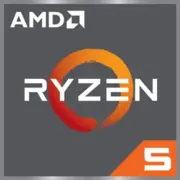AMD Ryzen 5 PRO 3350G

AMD Ryzen 5 PRO 3350G: A Budget Processor with Integrated Graphics for Office and Home
(Relevant as of March 2025)
Key Features: Architecture and Performance
The AMD Ryzen 5 PRO 3350G processor, released in 2021, remains a popular choice for budget builds due to its balance of price and capabilities. It is built on the Zen 2 architecture but manufactured using a 12nm process (unlike newer 7nm chips). This is a quad-core processor with 8 threads supported by SMT technology. The L3 cache size is 4 MB, modest compared to modern counterparts, but sufficient for basic tasks.
Key Features:
- Integrated Radeon Vega 8 Graphics (8 compute units) — allows for gaming and applications without a discrete graphics card in less demanding settings.
- Low TDP of 65W — energy efficient with minimal heat generation.
- PRO series technologies — support for AMD Secure Processor (data encryption) and DASH management for corporate systems.
Performance:
In Geekbench 6 testing (2025), the processor scores 1125 points in single-thread and 3713 in multi-thread modes. This is adequate for working with office applications, browsers, streaming video, and light gaming such as CS:GO or Dota 2 on low settings (50-60 FPS).
Compatible Motherboards: Sockets and Chipsets
The Ryzen 5 PRO 3350G uses the AM4 socket, opening access to a wide range of boards. Recommended chipsets:
- B550 — optimal choice: supports PCIe 4.0, memory overclocking, and stable power delivery. Example: ASUS TUF Gaming B550-Plus ($120).
- A520 — budget boards without overclocking (suitable: Gigabyte A520M DS3H, $70).
- X570 — excessive for this CPU but suitable for future upgrades.
Important:
- For B450/X470 chipset boards, a BIOS update may be required.
- PRO versions of motherboards (e.g., ASUS ProArt B550) are better compatible with the processor's corporate features.
Supported Memory
The processor works with DDR4 memory (up to 3200 MHz in dual-channel mode). To maximize integrated graphics performance, it is advisable to choose two DDR4-3200 modules (e.g., Kingston Fury Beast 16GB, $45). DDR5 and LPDDR4 are not supported.
Tip:
- Avoid memory with speeds lower than 2666 MHz — this could reduce FPS in games by 10-15%.
Power Supply Recommendations
With a TDP of 65W, the processor does not require a powerful power supply unit (PSU). For systems without discrete graphics cards, a 300-400W PSU will suffice (for instance, be quiet! System Power 10, 400W, $50). If planning to install a GPU like the NVIDIA GTX 1660, choose a PSU of 500-550W (Corsair CX550, $65).
Practical Experience:
Users report that even with cheaper power supplies (EVGA 450 BR), the system runs stably, but for reliability, it’s better to opt for models with an 80+ Bronze certification.
Pros and Cons
Pros:
- Low price ($130-150 in 2025).
- Integrated graphics for basic tasks.
- Energy efficiency and quiet operation.
- Support for corporate technologies.
Cons:
- Only 4 cores — weak for rendering or streaming.
- The 12nm process lags behind 7nm competitors in energy efficiency.
- No PCIe 4.0 support (only PCIe 3.0).
Use Cases
1. Office Tasks: Document editing, video conferencing, multitasking (20+ tabs in Chrome).
2. Multimedia: Streaming 4K videos, photo editing in Lightroom (with speed considerations).
3. Light Gaming: Minecraft, Overwatch, GTA V on low settings.
4. Home Server: Due to low TDP, suitable for NAS or media center setups.
Real-World Example:
A Reddit user built a PC with the Ryzen 5 PRO 3350G for study — simultaneously working with Zoom, Excel, and a browser without lag.
Comparison with Competitors
1. Intel Core i3-12100 (4 cores/8 threads, $130):
- Higher single-thread performance (Geekbench 6: ~1300 points), but lacks integrated graphics up to Vega 8 standard.
- Better for gaming when paired with a discrete GPU.
2. AMD Ryzen 5 5600G (6 cores/12 threads, $180):
- More powerful Vega 7 graphics (ironically — due to the Zen 3 architecture).
- 30% higher multi-thread performance.
Conclusion: The Ryzen 5 PRO 3350G only excels in scenarios with a limited budget and a need for corporate features.
Practical Build Tips
1. Motherboard: Choose a B550 with HDMI 2.0 for 4K output.
2. Memory: 2x8 GB DDR4-3200 — minimum for gaming.
3. Cooling: The stock cooler is sufficient, but for quiet operation, consider a DeepCool GAMMAXX 400 ($25).
4. Storage: Ensure to include an SSD (e.g., Crucial P3 500 GB, $40) — an HDD will slow down the system.
Final Verdict: Who is the Ryzen 5 PRO 3350G For?
This processor is an ideal choice for:
- Office PCs — low power consumption and data protection.
- Budget home systems — for streaming Netflix and document work.
- Parents and students — reliability and sufficient performance for an affordable price.
Why You Might Not Want It: If you plan to game with high settings or work with 3D models, it’s better to invest an additional $50-70 for the Ryzen 5 5600G or Intel i3-13100. However, for tasks where stability and cost-effectiveness are key, the Ryzen 5 PRO 3350G remains relevant even in 2025.
Basic
CPU Specifications
Memory Specifications
GPU Specifications
Miscellaneous
Benchmarks
Compared to Other CPU
Share in social media
Or Link To Us
<a href="https://cputronic.com/cpu/amd-ryzen-5-pro-3350g" target="_blank">AMD Ryzen 5 PRO 3350G</a>